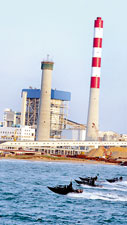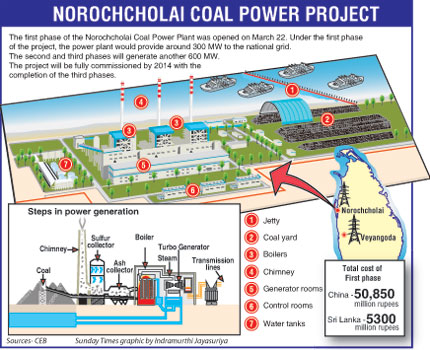The government aims to provide the entire country with electricity by 2012, said Minister of Power and Energy, Patali Champika Ranawaka.
Speaking to the Sunday Times, the Minister was expanding on the benefits of the newly opened Lakvijaya coal power plant in Norochcholai, Puttalam, which will boost the country’s power supply by 900 megawatts (MW).
 |
| The Lakvijaya coal power plant will add 900 MW to the national grid. |
Lakvijaya, the country’s first coal power plant, will have a total capacity of 900 megawatts (MW). The first phase will have a capacity of 300 MW, and the second and third phases, to be commissioned by 2014, will produce the balance 600 MW.
But electricity tariffs will not drop overnight when Lakvijaya comes into operation. The Ceylon Electricity Board (CEB) will have to first factor in the cost of distributing electricity across the country before tariffs can reflect cost benefits from the new plant, the minister explained.
Any adjustment to tariffs will be decided by the Public Utilities Commission of Sri Lanka (PUCSL), and adjustments will be based on CEB earnings, the Minister told the Sunday Times.
“Tariffs have been reduced by 25 per cent for religious institutions, schools, universities, hospitals and government offices,” the Minister said. “There will be no tariff increases for consumers who have been using less than 90 units of electricity since 2008.”
Suggestions for setting up a coal power plant came up when the country experienced repeat power failures and shortages in the 1990s. At the time, the country depended on a single hydropower system.
“During this period, the CEB was forced to buy electricity from the private sector,” the Minister said. “Also, the so-called international power agencies were refusing to fund new power projects. So the CEB had to buy power from independent power producers.”
Sri Lanka has 11 oil power plants. All 11 are independent entities running at different cost levels. The cost of producing one kilowatt hour (Kwh) is Rs. 19. The CEB sells a unit for Rs.13. At a loss of Rs. 6 per Kwh, the CEB incurs a loss of Rs. 27 billion, the Minister said.
Sri Lanka’s second coal power project, in Sampur, Trincomalee, will start operations in 2018, and will have a capacity of 500 MW. This will be a Sri Lanka-India joint venture between the CEB and the National Thermal Power Corporation (NTPC), India’s largest power-generating company.
“The Sampur project was delayed by the war situation around the Trincomalee area and protests led by the Tamil National Alliance and the LTTE,” Minister Ranawaka said. “Various modalities were sorted out during discussions with the National Thermal Power Corporation.
“NTPC representatives are in the country, and we expect to finalise the memorandum of understanding between Sri Lanka and India on the Sampur plant this month,” he said.
The CEB signed agreements with private power suppliers between 1995 and 2005. Some of the conditions demanded by the private sector were not acceptable, the Minister said.
“Of the 11 independent power plants, six will be retired in the next five years. Some are subsidiaries of the CEB, and the rest belong to the private sector,” Minister Ranawaka said.
The CEB had not paid dues to the Ceylon Petroleum Corporation (CPC) up to 2006. As of December 31, 2009, the CEB had run up a CPC debt of Rs. 51 billion.
Prices had to be state controlled to cushion the consumer from the impact of world fuel price fluctuations. After the Treasury had reviewed CEB’s debt status, as of 2010, it was decided that a settlement of Rs. 16 billion would be paid to the CPC, leaving no further outstanding debts.
Extra remote villages in the country, including certain hill country areas and islands around the Jaffna peninsula, will be outside the range of the national grid and power network. These villages will be provided with “stand-alone” power solutions.
“Some 4,000 families will benefit from such solutions as solar power, mini-hydropower and wind power. In fact, 50 per cent of these families are already using stand-alone solutions,” the Minister said. “Transformers will be installed in these places.” |



